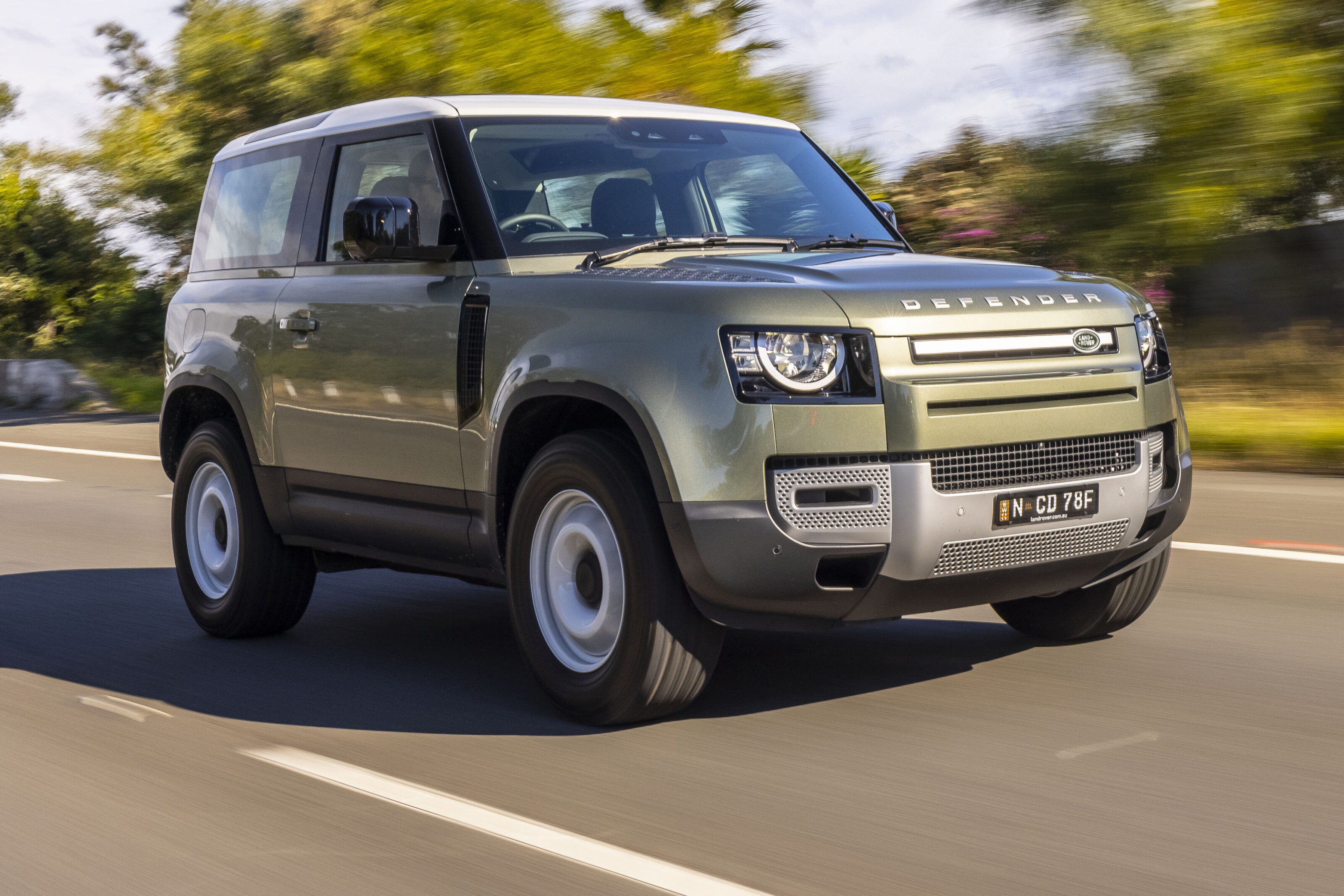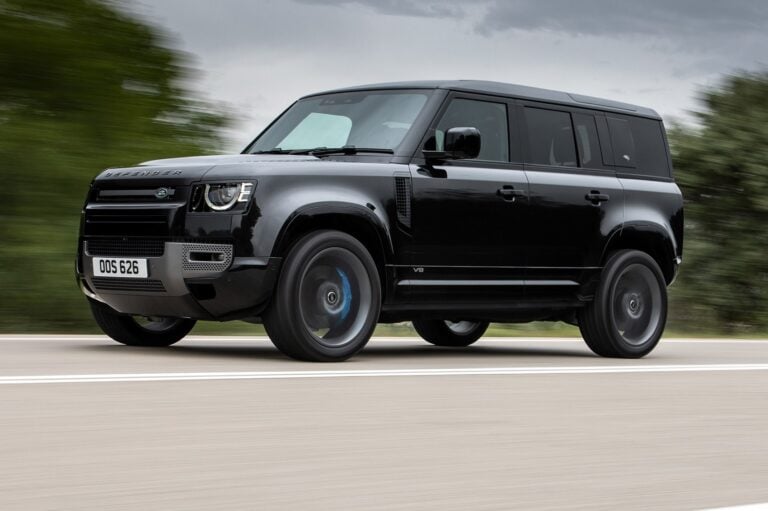Score breakdown
Things we like
- 3-door properly looks like a 21st-century Defender
- Urban nimbleness
- Torquey and refined straight-six diesel
- Interior’s blend of ruggedness and luxuriousness
Not so much
- Expensive even before any options
- Small boot
- 110 provides smoother ride
The all-new Land Rover Defender 110 introduced in 2020 proved doubters wrong – able to conquer scorching deserts and frozen tundras just like its legendary predecessors.
Technically, the newly arrived 90 version should be even more capable in the rough stuff. It shares the bigger Defender’s hardware, mechanicals, super-stiff monocoque platform and generous ground clearance but brings shorter dimensions, a superior breakover angle, and a tighter turning circle.
Yet, the 21st-century ‘Shorty’ is also aiming to be better equipped for those daily expeditions into the suburban jungle – the one terrain where the new Defender’s predecessors were challenged by their cramped cabin, bouncy ride, unwieldy steering and wide turning circle.
Land Rover believes most hardcore off-roaders will opt for the 110, as well as families, expecting the 90 to account for one in five Defender sales and appeal mostly to wealthy, design-loving urbanites.
And wealth is particularly useful, as even this more affordable version of the new-era Defender is far from cheap.
Where the last of the old Defenders cost from about $43,000 in 2016, entry to the 2021 model starts from $74,516 before on-road charges. Or more than $210,000 if you want the V8 version.
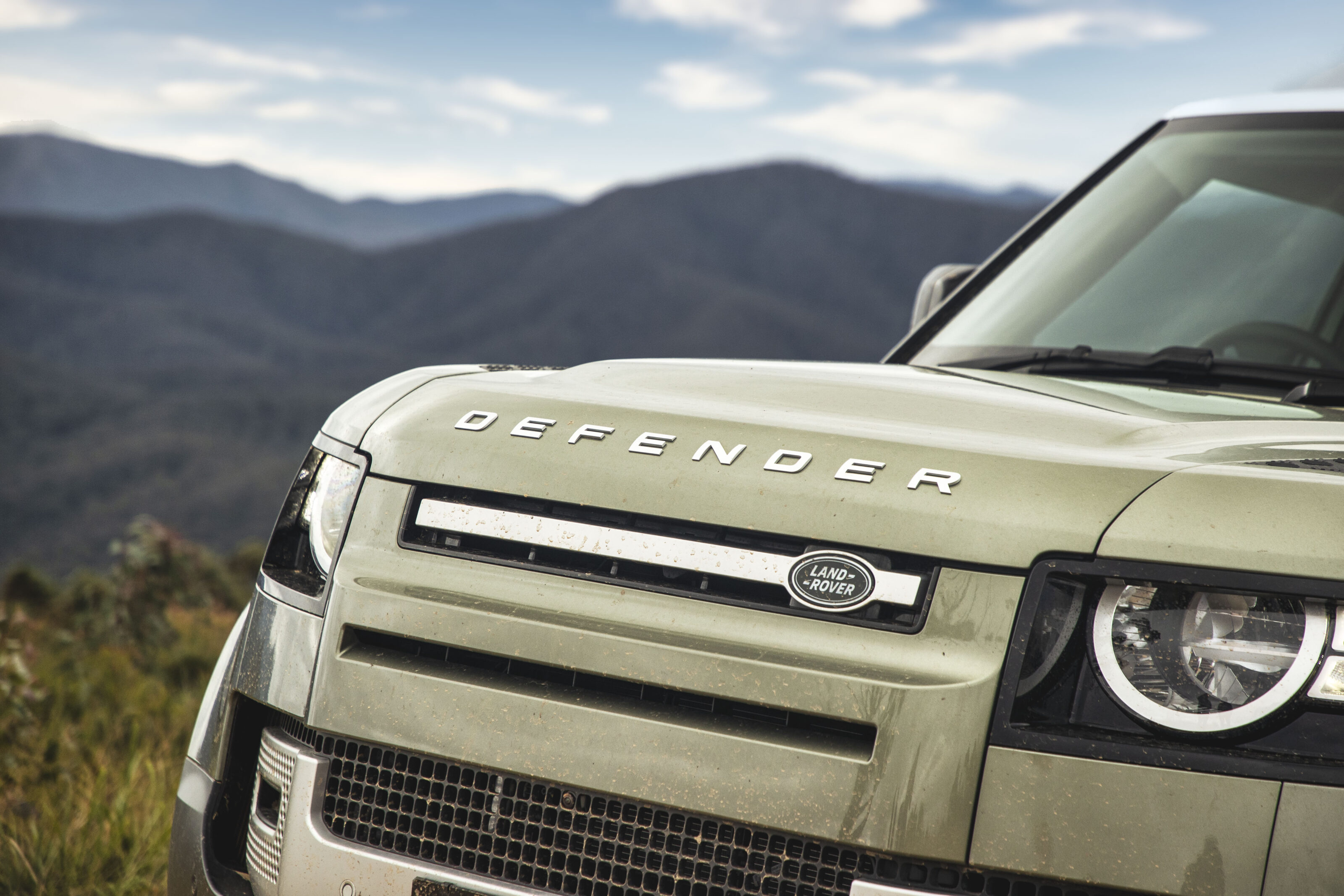
Across the range, the 90 is only $3000 less than an equivalent 110 that gives buyers another half-metre of car and two extra doors.
It could be argued that starting costs for this vehicle are almost irrelevant. The company says buyer interest in add-ons for the Defender is triple that of any Land Rover.
Beyond the choice of six trim grades (one less than the 110 range), there are about 170 individual options plus an array of option packages and accessories.
If you’re interested in the Defender, expect to spend plenty of time with the online configurator. You may well solve a Rubik’s Cube faster than determining the final spec of your vehicle.
(It’s also worth noting that the world’s microchip shortage means a potentially long wait for your Defender, particularly if it’s a model with lots of high-tech gear.)
Our test car for this launch review is a D250 S. D250 denotes a new, inline six-cylinder twin-turbo diesel engine that joins a lower-powered D200 four-cylinder, with both replacing four-cylinder diesels offered when the Defender 110 was released. The more powerful D300 engine is available only with the 110.
Neither will be as popular as the P300 four-cylinder or P400 six-cylinder petrol options, according to Land Rover Australia, while the range tops out with the P525 V8.
Engines, however, are restricted to specific trim grades.
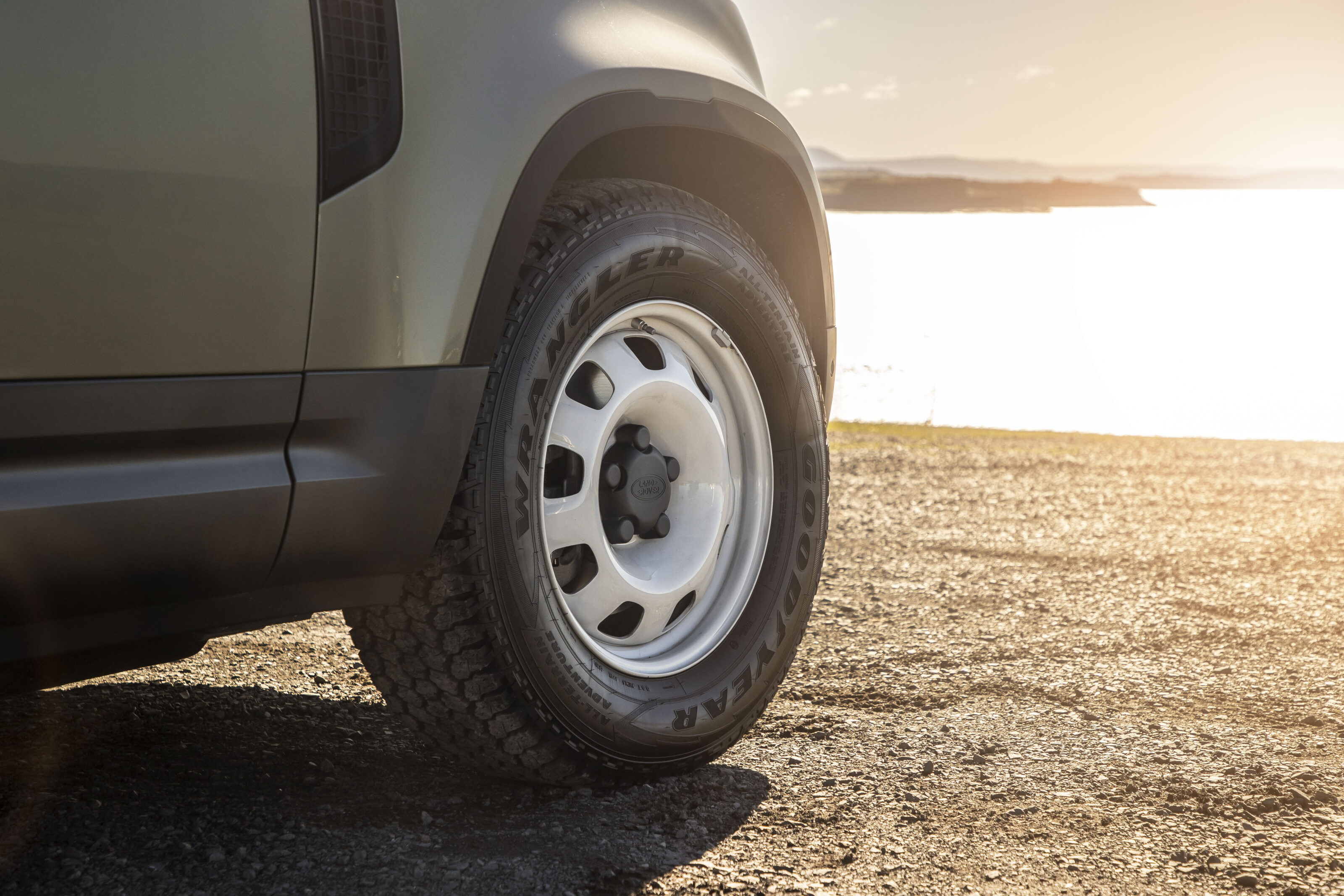
If you’re interested in the Defender, expect to spend plenty of time with the online configurator
With a healthy set of options added, our D250 S’s $90,326 RRP is transformed into an as-tested $108,388 (still before on-road costs). Go crazy with almost every conceivable option and you can comfortably exceed $150,000.
If the 90 is the Defender that more naturally invokes the design of the original, 1948 Land Rover, our test car’s exterior spec takes the imitation even further: Pangea Green paint, white contrast roof, white-painted steel wheels and even a safari-style folding fabric roof (all are cost options except the wheels).
The new Defender 90 is certainly sized more aptly for the city than the five-door 110 that stretches beyond five metres when including the tailgate-mounted spare wheel. The 4.3m-long 90 is slightly shorter than a Toyota Corolla hatch if you don’t count its rear-mounted spare, or just under 4.6 metres if you do.
Of the 43.5cm difference in length between the 90 and 100, every millimetre comes in the wheelbase. Both models share ridiculously short overhangs that are super-helpful when it comes to tackling hills.
The inevitable reduction of interior space in the 90 is most obvious in the boot. Where the 110 has 646 litres of luggage capacity measured up to the waistline in five-seat form (464L in 5+2 guise), the 90’s boot space is a tiny 240 litres (or 397L measuring up to the roof).
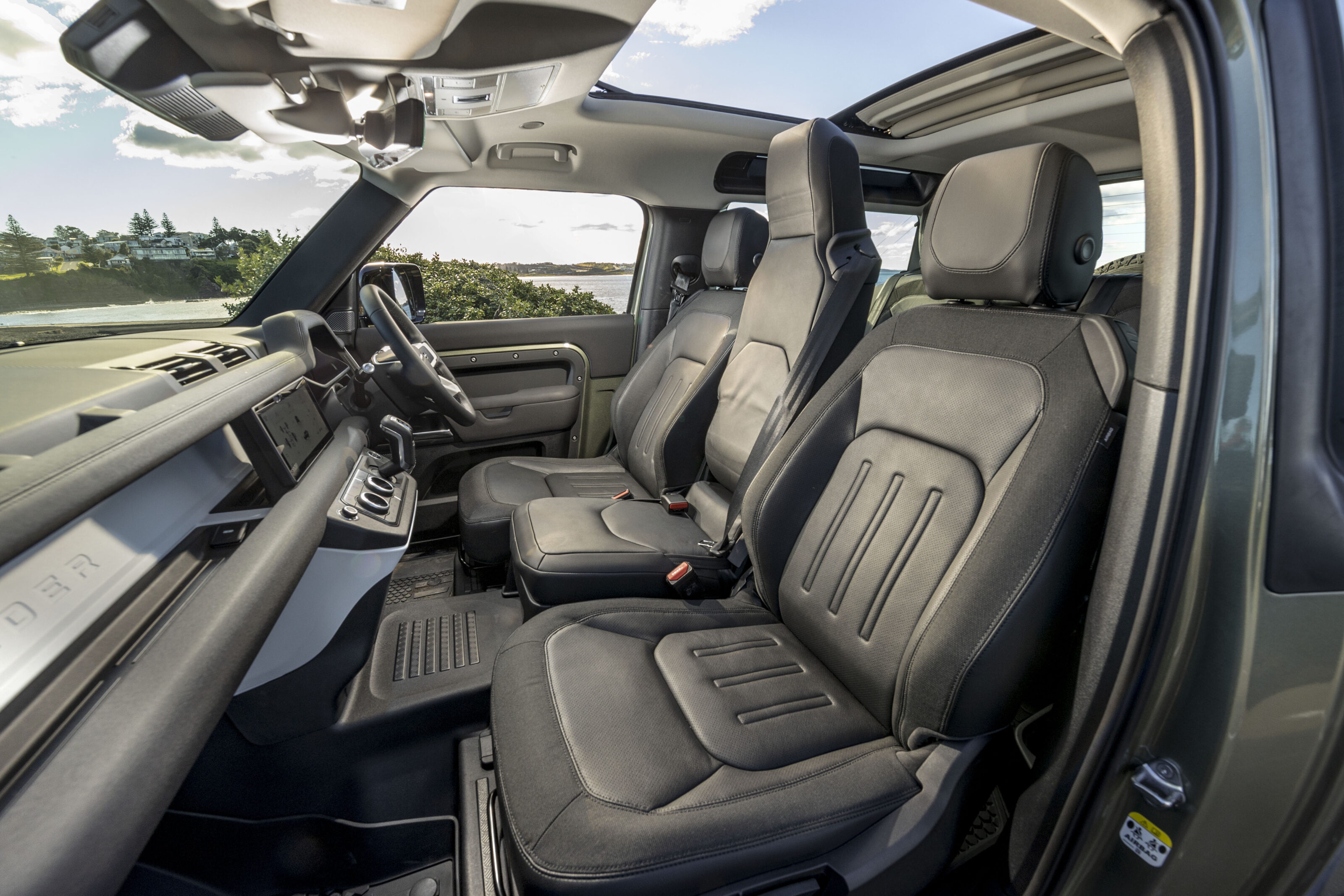
And while it shares a 40-20-40 rear seatback arrangement with the five-door Defender, the 90’s seats don’t lie flat and there’s a big step left when the seats fold.
The set-up will still be useful for lifestyle buyers without kids, and a full-sized racing bike, for example, can fit inside without having to remove its front wheel.
It’s a bit of a reach to pull the seats back into an upright position – and of course there are no rear doors to make the process easier.
The side-hinged tailgate is assisted for opening, making it less of a potential danger compared with the previous Defender, though the spare wheel ensures it feels heavy to close.
Access to the rear seat comes via tilt/slide front seats that are unique to the 90. The aperture is a bit squeezy for adults, though a sidestep and internal hand grip would be more helpful. (Side steps are available as an accessory.)
There may be less legroom compared with the 110, but the 90’s rear accommodation is not remotely cramped. Headroom with the folding fabric roof is just not as generous as you might expect for such a tall vehicle.
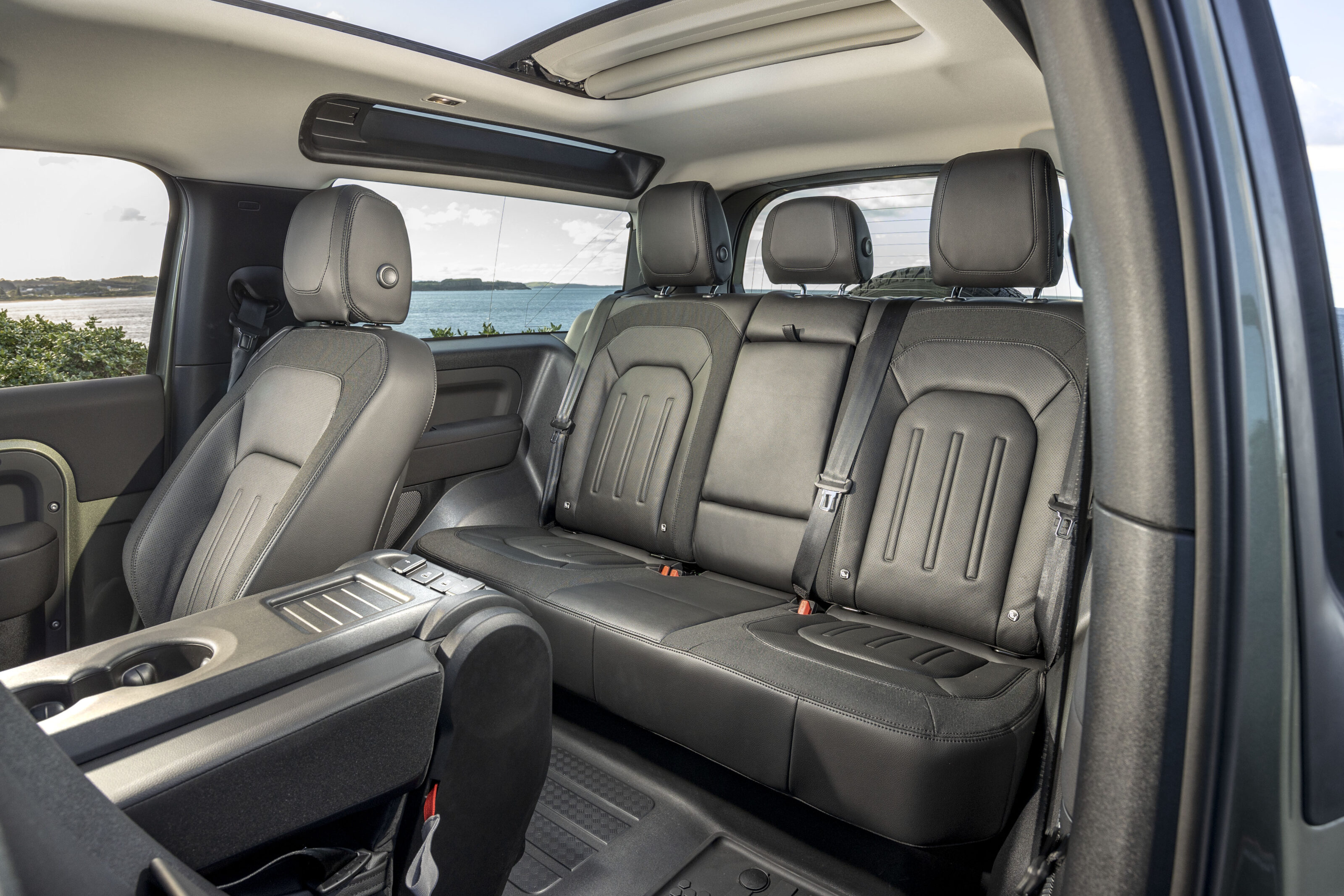
A near-flat floor and the wide cabin make it realistic to squeeze three adults into the back, though the bench is rather flat with a lack of cushion support so bums will shift around even in the outboard seats.
The floor areas by both outer seats feature a bottle holder and storage tray, while the centre armrest adds another couple of cupholders.
There are sockets galore. The rear console has two 12-volt and two USB ports; the seatbacks have another 5V USB port as well as Land Rover’s Click and Go attachment point for accessories such as mini-tables and tablet holders.
Jump into the driver’s seat and all looks more familiar from the 110 cabin experience – and an interior design that has far less in common with predecessors than the exterior.
The new Defender delivers a brilliant marriage of toughness and luxuriousness. There’s lots of squidgy yet rugged-looking plastics, while retro touches – including exposed screw-heads and visible paint – aren’t overdone.
And fully digital driver display and 10.0-inch centre touchscreen (or its 11.4-inch cost alternative) are anything but 1940s vintage.
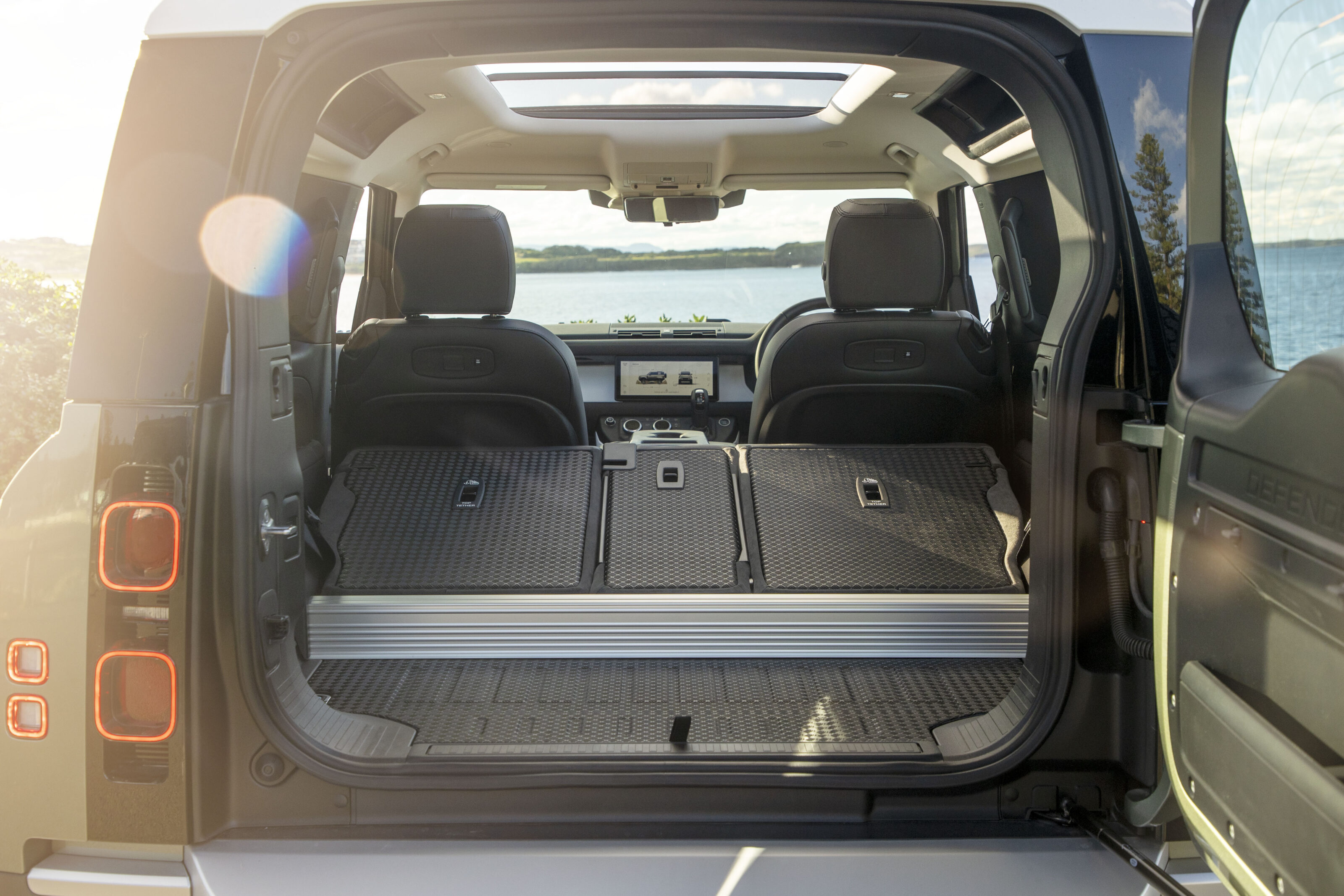
Land Rover’s Pivi Pro infotainment display and interface also improves upon the company’s stylish but flawed Touch Pro. Presentation, response, resolution and intuitiveness are all key areas better than before.
The digital instrument cluster can be customised, including the option of a full-screen nav-map option. Accessing information and changing layouts, done via steering wheel buttons, just seems a more complicated process than it needs to be (or is done by the likes of Audi and Volkswagen, for example).
The new Defender is about 20cm wider than before and the extra shoulder room in the cabin is noticeable. This also makes the optional front jump seat fitted to our car a viable spot for a passenger, if ideally a shorter one as the central floor area is very high.
When not in use, it simply folds down to act as a (rather bulky) centre console with two cupholders and shallow tray. A proper centre console is standard, and there’s also the other option of a walk-through set-up.
The jump seat’s skyscraper headrest blocks rear vision, which is probably why it’s not available without another option: JLR’s Clearsight rear-view mirror. Flick the tab that would usually dip the mirror to avoid dazzling and it turns into a video feed using a rear-facing camera integrated into the roof antenna. Clever.
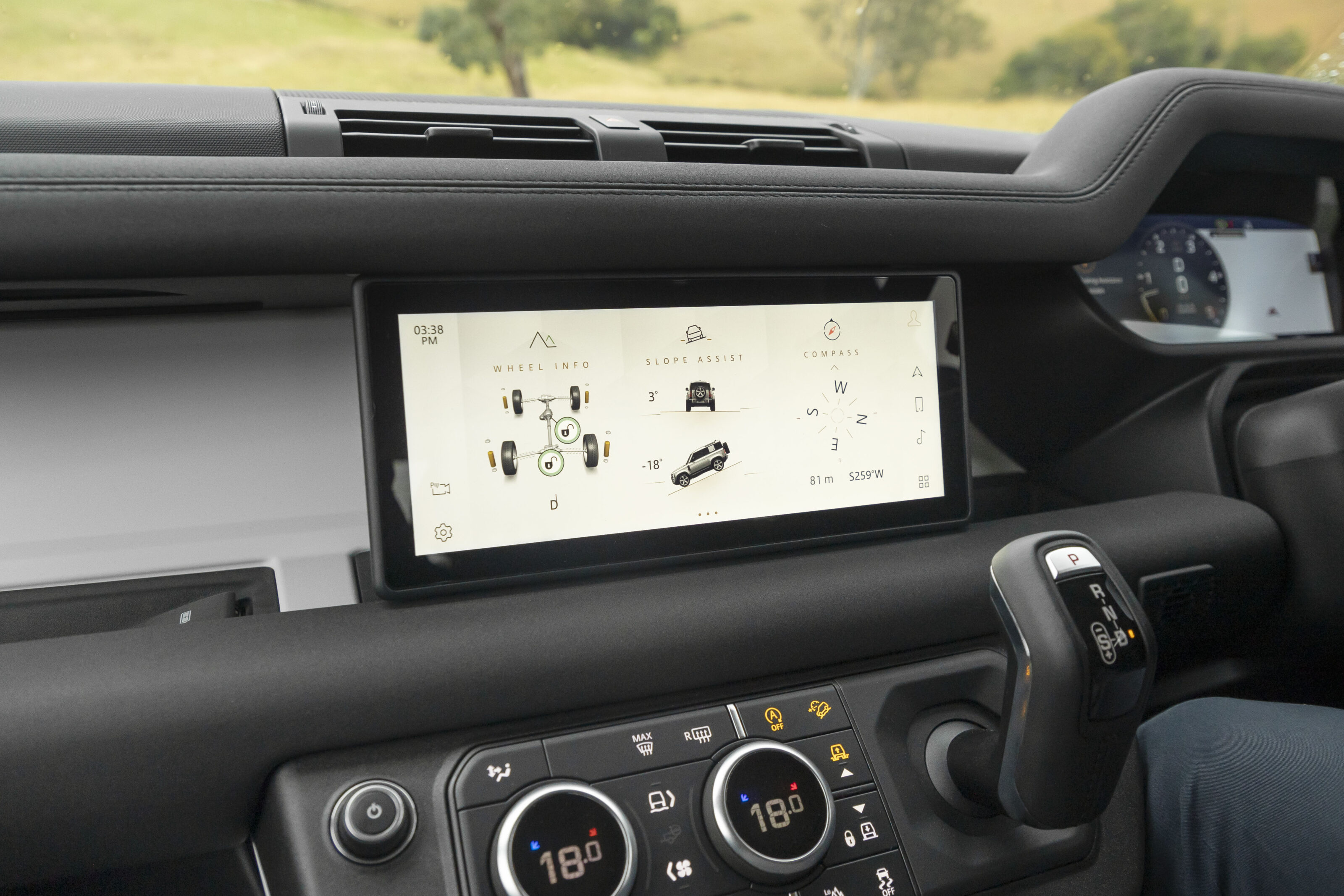
This also helps if the rear of the Defender is loaded with gear. Otherwise, the tailgate spare doesn’t excessively block the view out the back.
The view forward is surprisingly good despite chunky windscreen pillars and blocky side mirrors.
And while the bonnet looks huge up front, the Defender’s seating position is extremely elevated.
There are some obvious differences between the 90 and 110 on the road.
The shorter Defender, while far from a lightweight at 2.3 tonnes, feels more agile both around town and on a country road, and feels that bit keener to turn into corners if still exhibiting plentiful body roll.
While there are plenty of SUVs that display greater poise, the 90 shares the 110’s planted feel and accurate steering through bends that will seem totally alien to those who’ve driven a Series III or a 1990-2016 Defender.
Multi-storey car parks that could strike fear into those owners, too, but they’re a breeze to navigate in the 90, thanks to a relatively tight turning circle and steering that – like the 110’s – doesn’t require armfuls of wheel twirling.
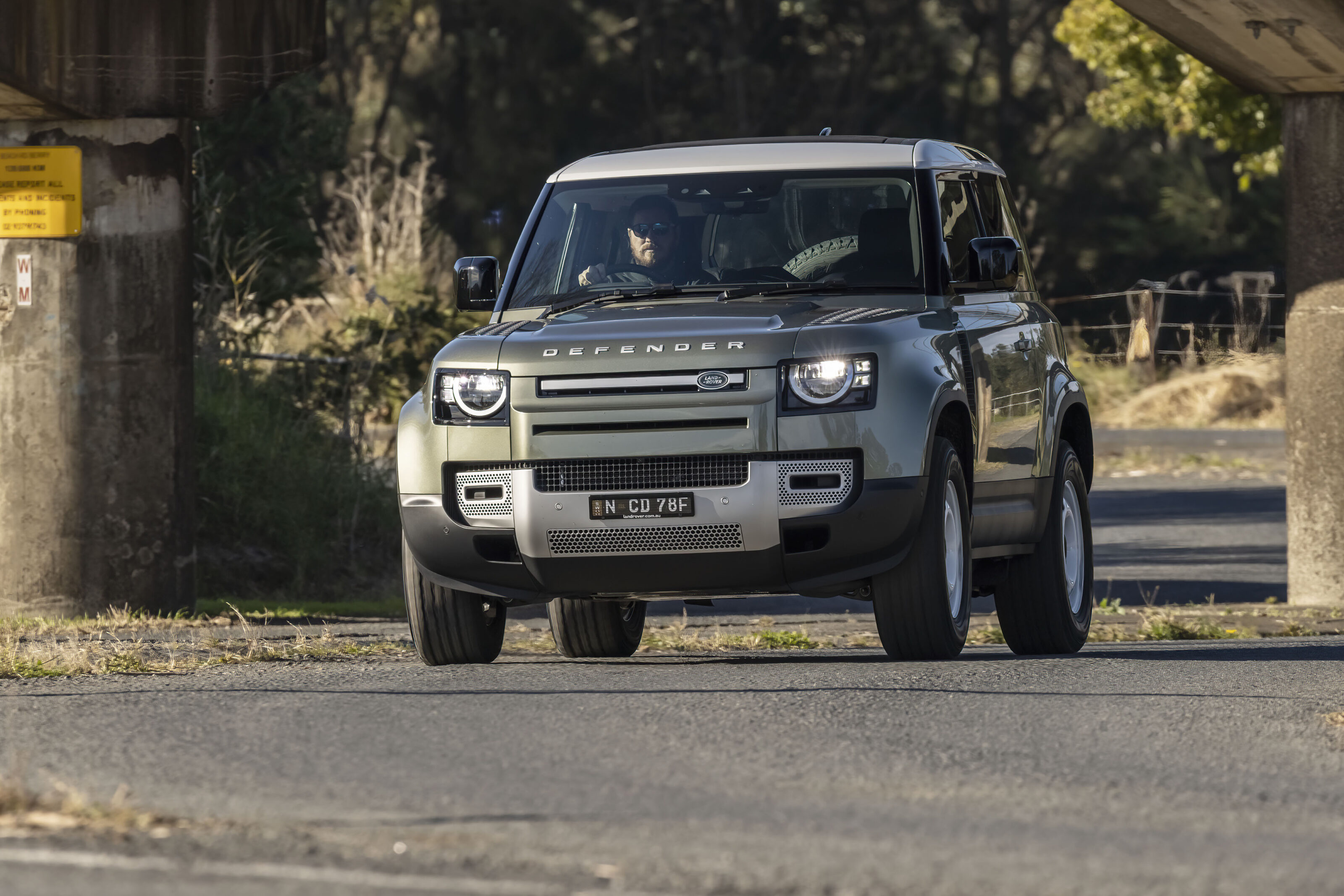
Our test car was fitted with optional adjustable air suspension over the standard coil springs, and as with the 110 it seems like a sensible pick for the advantages it brings in ride comfort and off-roading. (Air springs are standard on higher-spec Defenders.)
The 90 generally provides a comfortable ride if not quite as impressively compliant over bumpier roads as the 110, and there’s a more prominent forward/backward pitching motion that’s an inevitable consequence of its shorter wheelbase.
And a natural result of the Defender’s upright design is fairly intrusive wind noise, particularly on freeways, though our test car’s Goodyear Wrangler All-Terrain hybrid tyres were commendably quiet.
Noisy engines (and poor sound deadening) are also consigned to history.
The D250 straight-six twin-turbo diesel makes a worthy alternative to the cracking P400 petrol equivalent.
It’s not only surprisingly hushed for a diesel but provides an enjoyable combination of smoothness, response and grunt. Further differentiating it from your typical off-roader diesel, it sounds better the more you rev it.
With 183kW and 570Nm, there’s an extra 36kW/70Nm over the D200 entry diesel six and a near two-second gain in acceleration: 8.0sec v 9.8sec for the 0-100km/h sprint. All without using any more fuel based on official lab figures: both 7.9 litres per 100km.
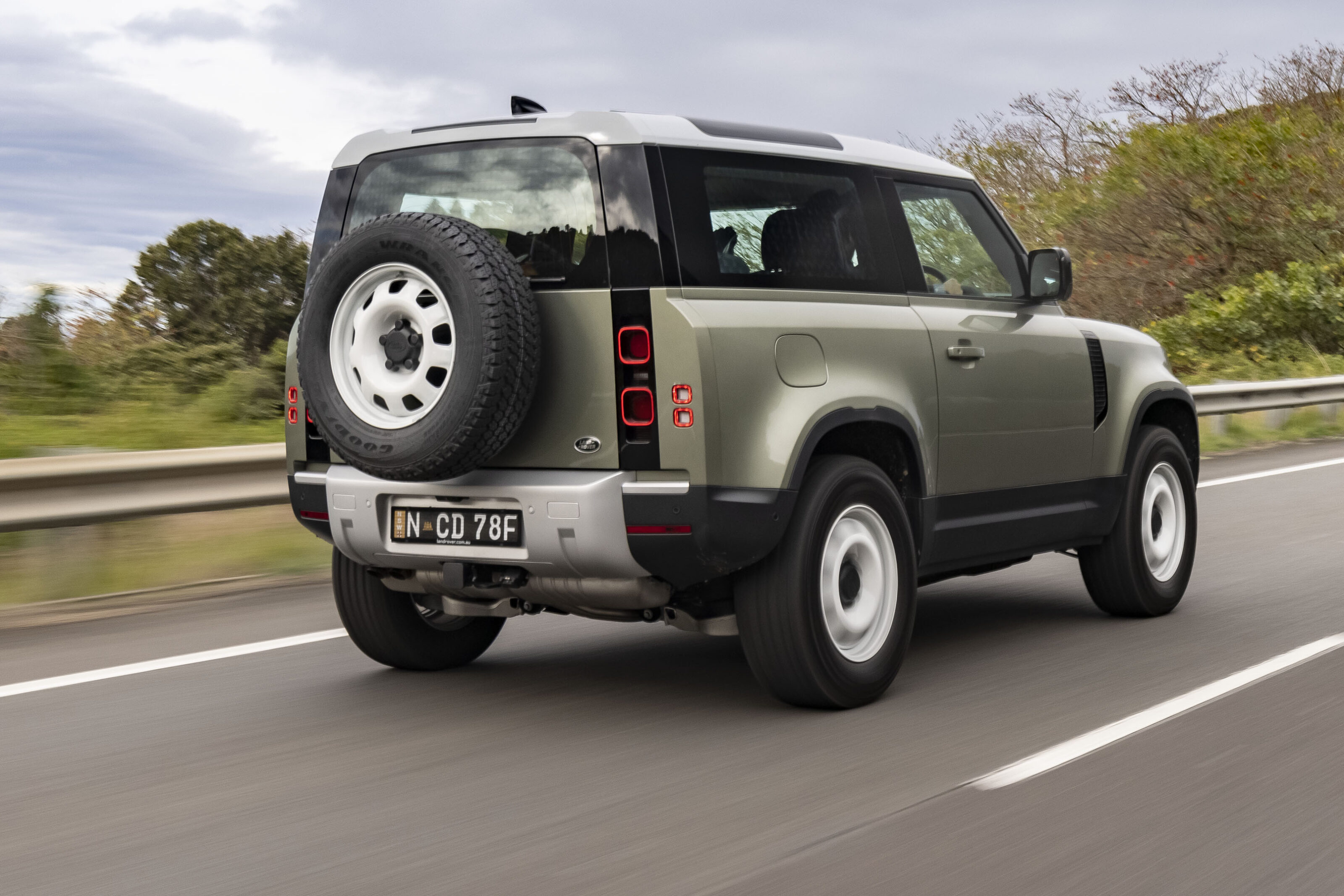
Both engines share mild-hybrid technology based around a 48V battery that helps to boost the D250’s low-rev response as well as aiding the stop-start system.
If lag isn’t eradicated, it’s certainly minimised. The eight-speed auto – smarter-witted than the nine-speed auto found in a Range Rover Evoque or Jaguar E-Pace – is excellent at shuffling gears swiftly to keep the engine on its toes.
All petrol engines, including the P300 four-cylinder, make the Defender quicker – up to 5.2 seconds for the 0-100km/h run if you choose the V8-powered P525.
They’re also thirstier and highly unlikely to match the commendable indicated 8.7L/100km we achieved in the D250 during testing.
Curiously, the smaller and (relatively) lighter 90’s ADR/81 fuel figures are identical to those of the 110 (the V8 variant is even a fraction thirstier, owing to the fitment of a petrol particulate filter).
With no fuel economy difference out of the buying decision process and minimal difference in price, it leaves a simple choice between the 90 and 110 Defenders.
Do you want the version with the superior ride comfort and significantly greater practicality, or do you want the ‘Shorty’ that’s nimbler around town and the strongest modern-day interpretation of Land Rover’s icon?
Or maybe it’s not so simple, as we’re torn.
2022 Land Rover Defender 90 D250 S specifications
| Model | 2021 Land Rover Defender 90 D250 S |
|---|---|
| Body | 3-door SUV |
| Drive | AWD (permanent) |
| Engine | 3.0-litre inline 6-cylinder turbo diesel |
| Transmission | 8-speed auto |
| Power | 183kW @ 4000rpm |
| Torque | 570Nm @ 1250-2500rpm |
| Bore/Stroke | 83.0/92.3mm |
| Compression ratio | 15.5:1 |
| 0-100km/h (claimed) | 8.0 seconds |
| Fuel consumption (combined) | 7.9L/100km |
| Weight | 2303kg |
| Towing capacity (braked) | 3500kg (350kg max towball weight) |
| Suspension | Front strut, rear multi-link |
| Length/Width/Height | 4583/2008/1969mm |
| Wheelbase | 2587mm |
| Brakes | 349mm front, 325mm rear |
| Tyres | Goodyear Wrangler 255/70R18 |
| Wheels | 18-inch steel |
| Price | $90,326 + ORC |
Score breakdown
Things we like
- 3-door properly looks like a 21st-century Defender
- Urban nimbleness
- Torquey and refined straight-six diesel
- Interior’s blend of ruggedness and luxuriousness
Not so much
- Expensive even before any options
- Small boot
- 110 provides smoother ride


